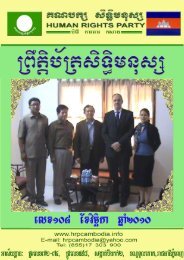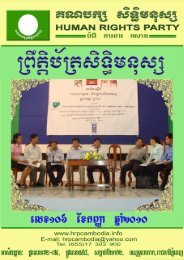Losing Ground - Human Rights Party.
Losing Ground - Human Rights Party.
Losing Ground - Human Rights Party.
Create successful ePaper yourself
Turn your PDF publications into a flip-book with our unique Google optimized e-Paper software.
<strong>Losing</strong> <strong>Ground</strong><br />
gradual strengthening of its relationship with China. A large<br />
dam is being built in Kampot by Chinese company Sinohydro<br />
Corp. partially with Chinese aid to Cambodia. International<br />
Rivers, which has studied that project extensively, says the<br />
Kamchay hydropower project’s reservoir will flood 2,000<br />
hectares of Bokor National Park.<br />
Another project known as Stung Atay is also under<br />
construction in the Cardamon Mountains in Pursat and is<br />
expected to flood a substantial area of protected forest.<br />
Memorandums of understanding have been signed for three<br />
other dams in Koh Kong.<br />
The Ministry of Industry Mines and Energy (MIME), which<br />
sets government policy for hydropower, also has preliminary<br />
plans to build a hydropower dam on the Mekong in Sambor<br />
in Kratie province within 10 years. A memorandum of<br />
understanding has been signed with a Chinese company.<br />
Ith Praing, Secretary of State for MIME, has said such<br />
a dam would be a “historic achievement as the first big<br />
dam in Cambodia.” The government also has an apparent<br />
memorandum of understanding with Electricity of Vietnam<br />
to develop feasibility plans for two dams on the Sesan.<br />
The Ministry of Environment is responsible for ensuring<br />
that environmental impact assessments for the projects are<br />
carried out. But in part due to a lack of proper sub-decrees<br />
regarding public participation, it is difficult for the ministry<br />
to carry out proper assessments.<br />
Who benefits?<br />
The Cambodian government is betting that a rapid boost of hydropower will fuel economic growth and expand electricity to rural areas.<br />
It also sees an opportunity to sell large quantities of electricity to neighboring countries. As a result, massive hydropower dams are being<br />
rapidly promoted: five are at various stages of construction and 13 more are in the planning and review stage.<br />
To attract investment, the government has been offering guaranteed power revenues risk-free to Chinese companies willing to finance,<br />
build, and then sell output to the state utility, Electricite du Cambodge. However, the livelihood of people living near and downstream<br />
of the dams is under threat, and they have yet to be guaranteed compensation for losses. Moreover, they may not even have access to the<br />
electricity these dams will produce. These already marginalized communities could be driven further into poverty.<br />
Who are the beneficiaries of these dams? Will the economic benefits of these projects outweigh the damage done to communities who<br />
depend on healthy rivers for their livelihood and food security? It remains unclear who will actually benefit from these projects and where<br />
the revenues from the dams will flow.<br />
The government has stated that it is committed to reducing poverty through economic development, so the rush into hydropower<br />
should be openly debated. Less environmentally destructive ways to meet the energy needs of the country, such as decentralized and<br />
renewable energy technologies, are abundant yet they are rarely discussed in public. Cambodia has the opportunity to display leadership<br />
and openness to innovation by adopting a more sophisticated, clean and appropriately-scaled power sector, which many experts agree<br />
would also ensure the benefits of development are shared. The alternative could be irreparable environmental and social damage that could<br />
eventually undermine the government’s efforts to attract investment.<br />
Source: NGO Forum<br />
Increased bluegreen<br />
algae and<br />
other forms of damrelated<br />
pollution<br />
are resulting in<br />
increasing skin<br />
diseases among those<br />
who bathe in the<br />
Sesan River, while<br />
buffalo and other<br />
livestock are dying<br />
after drinking from<br />
the river.<br />
54 Forced Evictions and Intimidation in Cambodia






